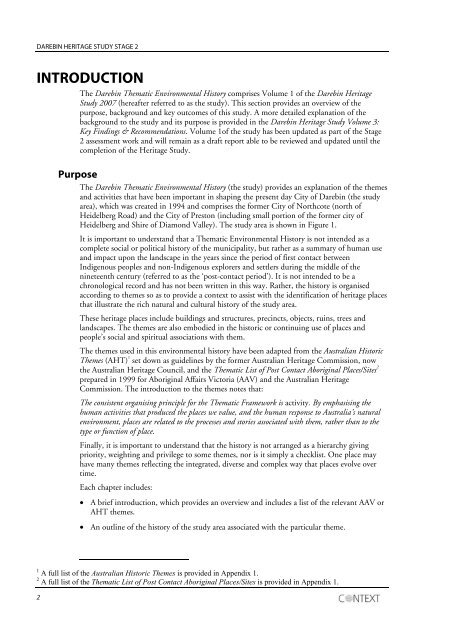City of Darebin Heritage Study Volume 1 Draft Thematic
City of Darebin Heritage Study Volume 1 Draft Thematic
City of Darebin Heritage Study Volume 1 Draft Thematic
Create successful ePaper yourself
Turn your PDF publications into a flip-book with our unique Google optimized e-Paper software.
DAREBIN HERITAGE STUDY STAGE 2INTRODUCTIONThe <strong>Darebin</strong> <strong>Thematic</strong> Environmental History comprises <strong>Volume</strong> 1 <strong>of</strong> the <strong>Darebin</strong> <strong>Heritage</strong><strong>Study</strong> 2007 (hereafter referred to as the study). This section provides an overview <strong>of</strong> thepurpose, background and key outcomes <strong>of</strong> this study. A more detailed explanation <strong>of</strong> thebackground to the study and its purpose is provided in the <strong>Darebin</strong> <strong>Heritage</strong> <strong>Study</strong> <strong>Volume</strong> 3:Key Findings & Recommendations. <strong>Volume</strong> 1<strong>of</strong> the study has been updated as part <strong>of</strong> the Stage2 assessment work and will remain as a draft report able to be reviewed and updated until thecompletion <strong>of</strong> the <strong>Heritage</strong> <strong>Study</strong>.PurposeThe <strong>Darebin</strong> <strong>Thematic</strong> Environmental History (the study) provides an explanation <strong>of</strong> the themesand activities that have been important in shaping the present day <strong>City</strong> <strong>of</strong> <strong>Darebin</strong> (the studyarea), which was created in 1994 and comprises the former <strong>City</strong> <strong>of</strong> Northcote (north <strong>of</strong>Heidelberg Road) and the <strong>City</strong> <strong>of</strong> Preston (including small portion <strong>of</strong> the former city <strong>of</strong>Heidelberg and Shire <strong>of</strong> Diamond Valley). The study area is shown in Figure 1.It is important to understand that a <strong>Thematic</strong> Environmental History is not intended as acomplete social or political history <strong>of</strong> the municipality, but rather as a summary <strong>of</strong> human useand impact upon the landscape in the years since the period <strong>of</strong> first contact betweenIndigenous peoples and non-Indigenous explorers and settlers during the middle <strong>of</strong> thenineteenth century (referred to as the ‘post-contact period’). It is not intended to be achronological record and has not been written in this way. Rather, the history is organisedaccording to themes so as to provide a context to assist with the identification <strong>of</strong> heritage placesthat illustrate the rich natural and cultural history <strong>of</strong> the study area.These heritage places include buildings and structures, precincts, objects, ruins, trees andlandscapes. The themes are also embodied in the historic or continuing use <strong>of</strong> places andpeople’s social and spiritual associations with them.The themes used in this environmental history have been adapted from the Australian HistoricThemes (AHT) 1 set down as guidelines by the former Australian <strong>Heritage</strong> Commission, nowthe Australian <strong>Heritage</strong> Council, and the <strong>Thematic</strong> List <strong>of</strong> Post Contact Aboriginal Places/Sites 2prepared in 1999 for Aboriginal Affairs Victoria (AAV) and the Australian <strong>Heritage</strong>Commission. The introduction to the themes notes that:The consistent organising principle for the <strong>Thematic</strong> Framework is activity. By emphasising thehuman activities that produced the places we value, and the human response to Australia’s naturalenvironment, places are related to the processes and stories associated with them, rather than to thetype or function <strong>of</strong> place.Finally, it is important to understand that the history is not arranged as a hierarchy givingpriority, weighting and privilege to some themes, nor is it simply a checklist. One place mayhave many themes reflecting the integrated, diverse and complex way that places evolve overtime.Each chapter includes:• A brief introduction, which provides an overview and includes a list <strong>of</strong> the relevant AAV orAHT themes.• An outline <strong>of</strong> the history <strong>of</strong> the study area associated with the particular theme.1 A full list <strong>of</strong> the Australian Historic Themes is provided in Appendix 1.2 A full list <strong>of</strong> the <strong>Thematic</strong> List <strong>of</strong> Post Contact Aboriginal Places/Sites is provided in Appendix 1.2
















